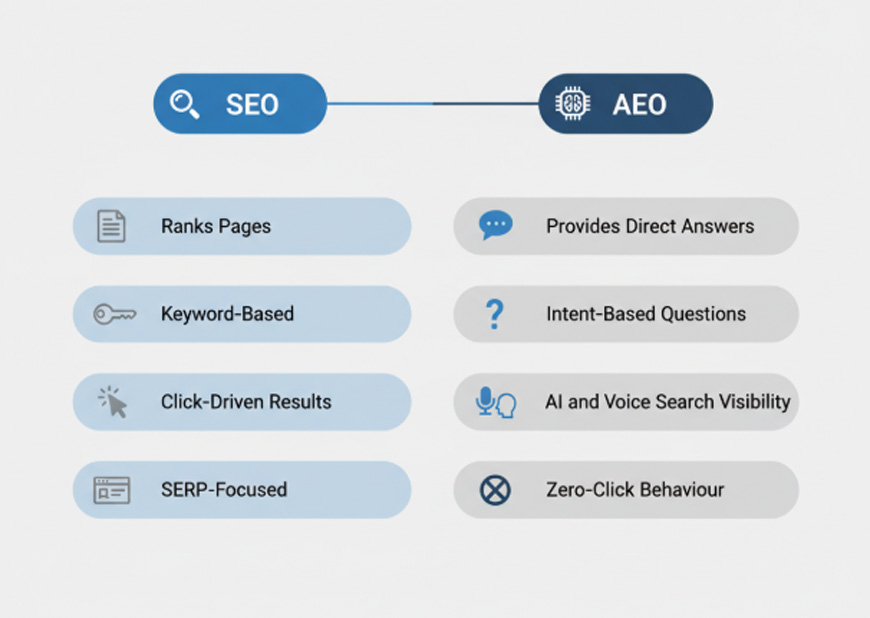From SEO to AEO: How to Optimize for AI-Driven Answer Engines
A major shift is happening in how people search. A growing number of buyers no longer scroll through result pages or weigh multiple links before making a decision. Instead, they ask a question in an AI tool, voice assistant, or conversational search engine, and an instant answer appears.
No clicks, no scrolling, and often no site visits.
This shift creates a new visibility challenge and a gap that many brands are not prepared for.
When content is not selected, summarized, or cited as part of that instant answer, the expertise remains invisible. The website might still "rank," but it no longer guarantees that buyers actually see the brand's offerings.
For B2B companies, this shift has major implications. Buyers are busy. They expect fast clarity. They trust answers that feel authoritative and concise. If the brand isn't one of the sources powering those answers, there is a risk of losing attention at the exact moment when interest and intent are highest.
This is the role of Answer Engine Optimization (AEO).
It's how brands ensure they are not just searchable, but selected, cited, and surfaced as the answer.
And this is where MacRAE'S helps companies build real visibility in the new AI-driven search landscape.
Traditional SEO is about ranking.
AEO is about being the answer.
The goal is simple:
When a decision-maker asks a question, the information extracted and presented should come from the brand's content.
But AEO builds on this because modern search doesn't just rank answers; it generates them.
Here's why AEO is essential today:
1. Zero-Click Search Is Increasing
A growing portion of search behaviour ends without a single click.
The answer appears directly on the screen. What this means is visibility now depends on whether AI pulls from the content, not whether the page is listed on rank one.
2. AI Tools Are Replacing Search for Many Users
More professionals now:
3. B2B Buyers Want Fast, Confident Answers
The typical B2B buyer's journey involves multiple stakeholders, technical details, and extensive research. AI-generated answers reduce that friction, so buyers naturally gravitate to the path of least resistance.
Being visible in these answers positions the brand as credible before the first human interaction.
4. Authority Matters More Than Ever
AI tools lean heavily on signals of:
5. Industry Adoption Is Accelerating
Brands investing in AEO servicesnow are quietly becoming the "default sources" for critical queries in their industries.
Here are the fundamentals that drive results:
1. Intent-Based Query Mapping
AI tools rely heavily on questions.
That means the content needs to align with the most common queries the target audience asks.
MacRAE'S typically begins with a structured process that includes mapping:
2. Clear, Direct Answers Up Front
AI systems extract answers from the top of the content.
The first-paragraph structure plays a critical role.
For each central question:
3. Structured Content for Machine Readability
AI models favour content that is:
4. Strong Schema Markup & Metadata
AEO relies on structured data that clarifies meaning for LLMs.
This includes:
5. Authority & Trust Signals
AI tools favour sources that demonstrate credibility beyond the page itself.
This includes:
6. Technical Performance Still Matters
Despite the AI revolution, foundational SEO signals still influence AEO results.
This includes:
7. Ongoing Monitoring and Refinement
AEO is never a one-time task.
MacRAE'S typically evaluates:
1. Writing for keywords instead of questions
AEO requires natural language, not keyword stuffing.
2. Burying the answer under lengthy introductions
AI systems may not prioritize content with buried answers.
3. Weak or missing schema markup
This makes it harder for machines to interpret the content.
4. Lack of unique insights or subject-matter clarity
AI ignores content that feels generic or shallow.
5. Treating AEO as separate from SEO
The two must work together, not independently.
6. No ongoing monitoring
AI search changes rapidly. Content must evolve accordingly.
Our approach focuses on:
This is not about replacing SEO.
It's about expanding the brand's visibility into the next generation of search.
1. Audit existing content for answer-ready structure
Identify where the answer is missing, buried, or unclear.
2. Build a list of question-based headings and long-tail conversational queries
These should reflect what buyers genuinely ask.
3. Rewrite core pages with direct, immediate answers
Start strong. Clarify early. Expand after.
4. Implement schema markup across high-intent pages
FAQ, HowTo, Article, and Organization schema are essential.
5. Strengthen authority signals
Update content regularly, improve referencing, partner with credible publications, and ensure consistency.
6. Monitor AI-search visibility
Track citations, summaries, and AI-driven referrals.
7. Iterate every quarter
AEO evolves quickly, requiring ongoing content refinement.
AI-powered tools are now the first stop for many professionals seeking solutions, explanations, and recommendations.
Ranking alone is no longer enough. Visibility now depends on being part of the answer.
AEO with proper AI SEO services helps your brand meet that moment. It clarifies expertise, elevates authority, and positions the content where modern buyers are actually searching.
MacRAE'S helps businesses navigate this shift with strategies built for real-world B2B visibility.
Brands looking to improve visibility across AI-driven search can begin strengthening their strategy today.
No clicks, no scrolling, and often no site visits.
This shift creates a new visibility challenge and a gap that many brands are not prepared for.
When content is not selected, summarized, or cited as part of that instant answer, the expertise remains invisible. The website might still "rank," but it no longer guarantees that buyers actually see the brand's offerings.
For B2B companies, this shift has major implications. Buyers are busy. They expect fast clarity. They trust answers that feel authoritative and concise. If the brand isn't one of the sources powering those answers, there is a risk of losing attention at the exact moment when interest and intent are highest.
This is the role of Answer Engine Optimization (AEO).
It's how brands ensure they are not just searchable, but selected, cited, and surfaced as the answer.
And this is where MacRAE'S helps companies build real visibility in the new AI-driven search landscape.
What Is Answer Engine Optimization (AEO)?
Answer Engine Optimization (AEO) is the practice of structuring the content so AI-powered systems, such as ChatGPT, Bing Copilot, Gemini, Perplexity, and voice assistants, can pull it directly as an authoritative answer.Traditional SEO is about ranking.
AEO is about being the answer.
The goal is simple:
When a decision-maker asks a question, the information extracted and presented should come from the brand's content.
How AEO Differs From Traditional SEO
AEO shifts the focus from just keywords to:- Intent-driven question formats ("What is…", "How to…", "Why does…").
- Placing direct, succinct answers at the top of the page.
- Structured content that AI can easily parse.
- Schema markup that clarifies meaning for machines.
- Clear authority signals that help AI models trust the brand's content.
But AEO builds on this because modern search doesn't just rank answers; it generates them.
Why AEO Matters Right Now
AI-generated answers are not a small trend. They are reshaping how B2B buyers research solutions, evaluate vendors, and shortlist partners.Here's why AEO is essential today:
1. Zero-Click Search Is Increasing
A growing portion of search behaviour ends without a single click.
The answer appears directly on the screen. What this means is visibility now depends on whether AI pulls from the content, not whether the page is listed on rank one.
2. AI Tools Are Replacing Search for Many Users
More professionals now:
- Ask ChatGPT before they Google
- Use voice assistants while multitasking
- Rely on AI summaries to scan large topics in seconds
- Trust conversational search engines for instant insight
3. B2B Buyers Want Fast, Confident Answers
The typical B2B buyer's journey involves multiple stakeholders, technical details, and extensive research. AI-generated answers reduce that friction, so buyers naturally gravitate to the path of least resistance.
Being visible in these answers positions the brand as credible before the first human interaction.
4. Authority Matters More Than Ever
AI tools lean heavily on signals of:
- Expertise
- Reliability
- Clarity
- Consistency
5. Industry Adoption Is Accelerating
Brands investing in AEO servicesnow are quietly becoming the "default sources" for critical queries in their industries.

How AEO Works: The Core Components
AEO isn't guesswork. It's structured, methodical, and measurable.Here are the fundamentals that drive results:
1. Intent-Based Query Mapping
AI tools rely heavily on questions.
That means the content needs to align with the most common queries the target audience asks.
MacRAE'S typically begins with a structured process that includes mapping:
- High-intent customer questions
- Industry-specific terminology
- Long-tail conversational queries
- Structured problem-solution formats
- Voice-search-friendly phrasing
2. Clear, Direct Answers Up Front
AI systems extract answers from the top of the content.
The first-paragraph structure plays a critical role.
For each central question:
- State the answer directly
- Keep it concise
- Maintain clarity
- Avoid filler or vague introductions
3. Structured Content for Machine Readability
AI models favour content that is:
- Well-formatted
- Easy to understand
- Logically ordered
- Rich with semantic cues
- H2 and H3 headings formatted as questions
- Bullet lists
- Numbered steps
- Definitions
- Comparison tables
- How-to sequences
- FAQ blocks
4. Strong Schema Markup & Metadata
AEO relies on structured data that clarifies meaning for LLMs.
This includes:
- FAQ schema
- HowTo schema
- Organization schema
- Article schema
- Product schema (where relevant)
5. Authority & Trust Signals
AI tools favour sources that demonstrate credibility beyond the page itself.
This includes:
- Presenting accurate information consistently
- Expertise shown through clear explanations
- Maintaining updates over time
- Clarity in brand identity
- High-quality backlinks
- Strong E-E-A-T principles (Experience, Expertise, Authoritativeness, Trustworthiness)
6. Technical Performance Still Matters
Despite the AI revolution, foundational SEO signals still influence AEO results.
This includes:
- Mobile performance
- Clean site architecture
- Fast load speed
- Proper indexing
- Secure browsing (HTTPS)
7. Ongoing Monitoring and Refinement
AEO is never a one-time task.
MacRAE'S typically evaluates:
- Which pages appear in AI answers
- Which queries do AI tools now cite
- What content gets summarized or ignored
- Patterns in conversational search behaviour
- Emerging query categories
- AI-driven traffic insights
Common AEO Pitfalls: What Holds Brands Back
Many businesses try to optimize for AEO but run into the same problems:1. Writing for keywords instead of questions
AEO requires natural language, not keyword stuffing.
2. Burying the answer under lengthy introductions
AI systems may not prioritize content with buried answers.
3. Weak or missing schema markup
This makes it harder for machines to interpret the content.
4. Lack of unique insights or subject-matter clarity
AI ignores content that feels generic or shallow.
5. Treating AEO as separate from SEO
The two must work together, not independently.
6. No ongoing monitoring
AI search changes rapidly. Content must evolve accordingly.
How MacRAE'S Supports AEO for B2B Brands
MacRAE'S helps companies strengthen their visibility in a search environment shaped by AI-generated answers. Our approach combines strategic content structuring, technical optimization, and ongoing analysis to support long-term visibility.Our approach focuses on:
- Understanding your audience's real questions
- Structuring content for both humans and machines
- Applying schema markup strategically
- Aligning technical SEO foundations with AEO needs
- Enhancing authority signals across the site
- Monitoring AI-search visibility as a separate performance layer
- Refining content based on emerging query patterns
This is not about replacing SEO.
It's about expanding the brand's visibility into the next generation of search.

Next Steps for Brands Starting Their AEO Journey
Here's a clear roadmap for building an AEO-ready content strategy:1. Audit existing content for answer-ready structure
Identify where the answer is missing, buried, or unclear.
2. Build a list of question-based headings and long-tail conversational queries
These should reflect what buyers genuinely ask.
3. Rewrite core pages with direct, immediate answers
Start strong. Clarify early. Expand after.
4. Implement schema markup across high-intent pages
FAQ, HowTo, Article, and Organization schema are essential.
5. Strengthen authority signals
Update content regularly, improve referencing, partner with credible publications, and ensure consistency.
6. Monitor AI-search visibility
Track citations, summaries, and AI-driven referrals.
7. Iterate every quarter
AEO evolves quickly, requiring ongoing content refinement.
The New Standard for Search Visibility
Search behaviour is changing faster than ever.AI-powered tools are now the first stop for many professionals seeking solutions, explanations, and recommendations.
Ranking alone is no longer enough. Visibility now depends on being part of the answer.
AEO with proper AI SEO services helps your brand meet that moment. It clarifies expertise, elevates authority, and positions the content where modern buyers are actually searching.
MacRAE'S helps businesses navigate this shift with strategies built for real-world B2B visibility.
Brands looking to improve visibility across AI-driven search can begin strengthening their strategy today.








